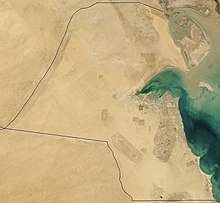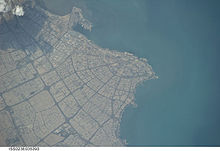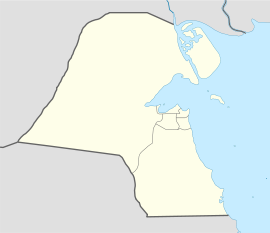Kuvajt (grad)
| Grad Kuvajt مدينة الكويت | |
|---|---|
Kuvajt | |
| Administrativni podaci | |
| Država | |
| Guvernorat | Al Asimah |
| Stanovništvo | |
| Stanovništvo | |
| — | 151.060 |
| — gustina | 755,3 st./km2 |
| Aglomeracija | 2.380.000 |
| Geografske karakteristike | |
| Koordinate | 29° 22′ 30″ S; 47° 58′ 48″ I / 29.375° S; 47.98° I |
| Površina | 200 km2 |
Grad Kuvajt (arap. مدينة الكويت) je glavni grad emirata Kuvajt. Po podacima iz 2006. grad ima 63.600 stanovnika, sa 2.388.688 stanovnika u širem području.[1] Nalazi se u centru kuvajtske obale Persijskog zaliva. U gradu se nalaze državni parlament, većina vladinih institucija i sedište najvećih korporacija i banaka.
Grad je osnovan početkom 18. veka. Osnovao ga je klan Al Sabah, koji je kasnije postao vladajuća porodica Kuvajta. Ime je verovatno dobio po arapskoj reči Kut (كوت), što znači tvrđava pored mora. Posle iračke okupacije (avgust 1990-februar 1991), i razaranja koje je grad doživeo u tom periodu, Kuvajt je brzo obnovljen i pretvoren u finansijski, trgovinski i hotelski centar međunarodnog značaja.
Geografija
[uredi | uredi izvor]
Grad Kuvajt se nalazi u Kuvajtskom zalivu, prirodnoj dubokovodnoj luci. 90% stanovništva Kuvajta živi na obali Kuvajtskog zaliva. Zemlja je uglavnom nisko ležeća, a najviša tačka je 306 m (1.004 ft) nadmorske visine.[2] Ima devet ostrva, od kojih su sva, sa izuzetkom ostrva Fajlak, nenaseljena.[3] Sa površinom od 860 km2 (330 sq mi), Bubijan je najveće ostrvo u Kuvajtu i povezano je sa ostatkom zemlje mostom dugim 2.380 m-long (7.808 ft).[4] Zemljište se smatra obradivim[2] i retka vegetacija se nalazi duž obale duge 499 km-long (310 mi) coastline.[2]
Kuvajtsko polje Burgan ima ukupan kapacitet od približno 70 Gbbl (1,1×1010 m3) dokazanih rezervi nafte. Tokom kuvajtskih naftnih požara 1991. godine stvoreno je više od 500 naftnih jezera koja pokrivaju ukupnu površinu od oko 35,7 km2 (13,8 sq mi).[5] Nastala kontaminacija tla usled akumulacije nafte i čađi učinila je istočne i jugoistočne delove Kuvajta nenastanjivim. Pesak i ostaci nafte su sveli velike delove kuvajtske pustinje na poluasfaltne površine.[6] Izlivanje nafte tokom Zalivskog rata takođe je drastično uticalo na morske resurse Kuvajta.[7]
Klima
[uredi | uredi izvor]
Grad Kuvajt ima vruću pustinjsku klimu (Kepen: BWh) sa izuzetno toplim, veoma dugim letima i blagim, kratkim zimama. To je jedan od najtoplijih letnjih gradova na svetu.[8] Prosečne letnje visoke temperature su iznad 45 °C (113 °F) tokom tri meseca u godini i tokom toplotnih talasa; dnevna temperatura redovno prelazi 50 °C (122 °F), a noćne niske često ostaju iznad 30 °C (86 °F). Zimi, noćne temperature često padaju ispod 8 °C (46 °F). S obzirom na njegov priobalni položaj i relativnu udaljenost od ekvatora u poređenju sa vrelom pustinjskom klimom u Africi i Saudijskoj Arabiji, vrućina u gradu je prilično ekstremna – okružen je vrelom pustinjom u skoro svim pravcima.
Peščane oluje se ponekad dešavaju tokom leta od šamalskog vetra. Peščane oluje se mogu pojaviti u bilo koje doba godine, ali se javljaju uglavnom tokom leta, a ređe tokom jeseni.
| Klima Kuvajt Sitija | |||||||||||||
|---|---|---|---|---|---|---|---|---|---|---|---|---|---|
| Pokazatelj \ Mesec | Jan. | Feb. | Mar. | Apr. | Maj | Jun | Jul | Avg. | Sep. | Okt. | Nov. | Dec. | God. |
| Apsolutni maksimum, °C (°F) | 29,8 (85,6) |
35,8 (96,4) |
41,2 (106,2) |
44,2 (111,6) |
49,0 (120,2) |
49,8 (121,6) |
52,1 (125,8) |
50,7 (123,3) |
47,7 (117,9) |
43,7 (110,7) |
37,9 (100,2) |
30,5 (86,9) |
52,1 (125,8) |
| Maksimum, °C (°F) | 19,5 (67,1) |
21,8 (71,2) |
26,9 (80,4) |
33,9 (93) |
40,9 (105,6) |
45,5 (113,9) |
46,7 (116,1) |
46,9 (116,4) |
43,7 (110,7) |
36,6 (97,9) |
27,8 (82) |
21,9 (71,4) |
34,3 (93,7) |
| Minimum, °C (°F) | 8,5 (47,3) |
10,0 (50) |
14,0 (57,2) |
19,5 (67,1) |
25,4 (77,7) |
28,9 (84) |
30,7 (87,3) |
29,5 (85,1) |
26,2 (79,2) |
21,5 (70,7) |
14,5 (58,1) |
9,9 (49,8) |
19,9 (67,8) |
| Apsolutni minimum, °C (°F) | −4,0 (24,8) |
−1,6 (29,1) |
−0,1 (31,8) |
6,9 (44,4) |
14,7 (58,5) |
20,4 (68,7) |
22,4 (72,3) |
21,7 (71,1) |
16,0 (60,8) |
9,4 (48,9) |
2,0 (35,6) |
−1,5 (29,3) |
−4,0 (24,8) |
| Količina kiše, mm (in) | 30,2 (1,189) |
10,5 (0,413) |
18,2 (0,717) |
11,5 (0,453) |
0,4 (0,016) |
0,0 (0) |
0,0 (0) |
0,0 (0) |
0,0 (0) |
1,4 (0,055) |
18,5 (0,728) |
25,5 (1,004) |
116,2 (4,575) |
| Dani sa kišom (≥ 0.1 mm) | 5 | 3 | 3 | 1 | 0 | 0 | 0 | 0 | 0 | 1 | 3 | 3 | 19 |
| Sunčani sati — mesečni prosek | 198,1 | 222,5 | 217,6 | 229,3 | 272,5 | 304,5 | 307,1 | 301,6 | 285,1 | 252,2 | 216,5 | 193,5 | 3.000,5 |
| Sunčani sati — dnevni prosek | 7,1 | 7,7 | 7,5 | 7,9 | 9,4 | 10,5 | 10,6 | 10,8 | 10,2 | 9,0 | 7,7 | 6,9 | 8,8 |
| Sunčano vreme — mesečni procenti | 68 | 69 | 63 | 62 | 69 | 77 | 76 | 78 | 77 | 79 | 72 | 67 | 72 |
| Izvor: World Meteorological Organization (temperature and rainfall 1994–2008);[9] NOAA (sunshine and records, 1961–1990);[10] Wundergound (2012 records)[11] | |||||||||||||
Partnerski gradovi
[uredi | uredi izvor] Isfahan
Isfahan Beverli Hils
Beverli Hils Kan
Kan Gazijantep
Gazijantep Monako
Monako Ankara
Ankara Meksiko Siti
Meksiko Siti Firenca
Firenca Tunis
Tunis Teheran
Teheran Sarajevo
Sarajevo Marbelja
Marbelja Rosario
Rosario
Reference
[uredi | uredi izvor]- ^ The World's Cities in 2018. Data Booklet (PDF), United Nations, Pristupljeno 2021-03-29
- ^ a b v „Kuwait”. The World Factbook. Central Intelligence Agency. 10. 4. 2015.
- ^ „Bubiyan (island, Kuwait)”. Encyclopædia Britannica. Pristupljeno 28. 6. 2010.
- ^ „Structurae [en]: Bubiyan Bridge (1983)”. En.structurae.de. 19. 10. 2002. Pristupljeno 28. 6. 2010.
- ^ Pendick, Daniel. „Kuwaiti Oil Lakes”. Encarta. Arhivirano iz originala 1. 11. 2009. g.
- ^ „The Economic and Environmental Impact of the Gulf War on Kuwait and the Persian Gulf”. American.edu. Arhivirano iz originala 19. 12. 2010. g. Pristupljeno 28. 6. 2010.
- ^ „Kuwait (country)”. Encarta. Arhivirano iz originala 21. 10. 2009. g. Pristupljeno 4. 7. 2011.
- ^ Birch, Hayley (22. 7. 2015). „Where is the world's hottest city?”. the Guardian. Pristupljeno 3. 3. 2016.
- ^ „World Weather Information Service – Kuwait City”. World Meteorological Organization. Arhivirano iz originala 09. 12. 2020. g. Pristupljeno 19. 2. 2014.
- ^ „Kuwait International Airport Climate Normals 1961–1990”. National Oceanic and Atmospheric Administration. Pristupljeno 15. 1. 2015.
- ^ „Dr. Jeff Masters' article published January 2013”. National Oceanic and Atmospheric Administration. Arhivirano iz originala 17. 1. 2013. g. Pristupljeno 20. 7. 2015.
Literatura
[uredi | uredi izvor]- James Horsburgh (1852). „Persian Gulf, West Side: Graen, or Grane, called also Quade”. India Directory: Or, Directions for Sailing to and from the East Indies, China, Australia, and the Interjacent Ports of Africa and South America (6th izd.). London: William H. Allen & Co. — preko Google Books.
- Edward Balfour (1885), „Koweit, also called Quade or Grave”, Cyclopaedia of India (3rd izd.), London: B. Quaritch, hdl:2027/mdp.39015068611014 — preko Hathi Trust, „Al Quaat”
- Wahab, Robert Alexander (1910). „Kuwēt”. Encyclopædia Britannica (na jeziku: engleski). 15 (11 izd.). str. 956.
- British Admiralty (1916). „Sultanate of Koweit: Towns: Koweit”. Handbook of Arabia. 1. London: British War Office. hdl:2027/njp.32101006882755.
- „Kuwait”. Persian Gulf Pilot. Washington DC: Government Printing Office. 1920.
- L.W. Amps (1953). „Kuwait Town Development”. Journal of the Royal Central Asian Society. UK. 40 (3–4): 234—240. doi:10.1080/03068375308731484.
- Abdul-llah Abu-Ayyash (1980). „Urban Development and Planning Strategies in Kuwait”. International Journal of Urban and Regional Research. 4.
- Najat Abd al-Qadir al-Jasim (1980). The Kuwait Municipality over 50 Years. Kuwait Municipality.
- Stephen Gardiner; Ian Cook (1983). Kuwait, the making of a city. Longman. ISBN 978-0-582-78356-0.
- Norconsult (1984), Public Transport in Kuwait Town and Urban Areas, Kuwait Municipality and Kuwait Transport Company
- Saleh Abdulghani Al-Mutawa (1994), History of Architecture in Old Kuwait City
- Yasser Elsheshtawy, ur. (2008). „Kuwait: learning from a globalized city”. The Evolving Arab City: Tradition, Modernity and Urban Development. Routledge. ISBN 978-1-134-12821-1.
- Angie Turner (2008), „Kuwait City”, Ur.: Michael R.T. Dumper; Bruce E. Stanley, Cities of the Middle East and North Africa, USA: ABC-CLIO, str. 229+, ISBN 9781576079195
- Farah al-Nakib (2013). „Kuwait's Modern Spectacle: Oil Wealth and the Making of a New Capital City, 1950–90”. Comparative Studies of South Asia, Africa and the Middle East. 33: 7—25. doi:10.1215/1089201X-2072694.
- Gwyn Lloyd Jones (2014). „Kuwait City, Kuwait”. Ur.: Murray Fraser; Nasser Golzari. Architecture and Globalisation in the Persian Gulf Region. Ashgate. str. 37—56. ISBN 978-1-4094-7098-4.
- „Arabia: Sultanate of Koweit”. Statesman's Year-Book. London: Macmillan and Co. 1921. hdl:2027/njp.32101072368440.
- Michael Herb (2014). The Wages of Oil: Parliaments and Economic Development in Kuwait and the UAE
 . Cornell University Press. ISBN 978-0-8014-5468-4.
. Cornell University Press. ISBN 978-0-8014-5468-4. - „Kuwait marks 50th anniversary of first municipal elections”. Kuwait News Agency. jun 2014.
- Leon E. Seltzer, ur. (1952), „Kuwait, Kuweit, or Al-Kuwayt”, Columbia Lippincott Gazetteer of the World, New York: Columbia University Press, str. 996, OL 6112221M, „Formerly called Qurein, Grane, or Grain”
- Malcolm C. Peck (2007). Historical Dictionary of the Gulf Arab States. USA: Scarecrow Press. ISBN 978-0-8108-6416-0.
- Abdul-llah Abu-Ayyash (1986). „Urban Public Transport Planning in Kuwait”. GeoJournal. 12 (3): 243—254. JSTOR 41143870.
- „Population of capital cities and cities of 100,000 and more inhabitants”. Demographic Yearbook 1965. New York: Statistical Office of the United Nations. 1966. str. 140—161.
- United Nations Department of Economic and Social Affairs, Statistical Office (1987). „Population of capital cities and cities of 100,000 and more inhabitants”. 1985 Demographic Yearbook. New York. str. 247—289.
- „Kuwait”. Europa World Year Book. Europa Publications. 2004. str. 2538+. ISBN 978-1-85743-255-8.
- Noura Alsager, ur. (2014). Acquiring Modernity. State of Kuwait, National Council for Culture, Arts and Letters. ISBN 978-99906-0-423-8. „Biennale di Venezia”
Spoljašnje veze
[uredi | uredi izvor]- „Statistical Reports: Population: Population Density by Governorate”. Government of Kuwait, Public Authority for Civil Information. 2014. Arhivirano iz originala 13. 03. 2014. g. Pristupljeno 14. 06. 2022.








